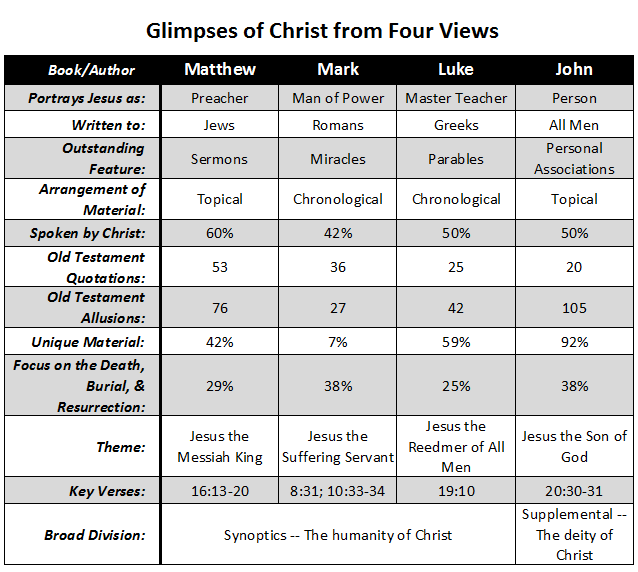This study will be based on the chronology of J.W. McGarvey's and Philip Pendleton's book entitled: The Fourfold Gospel. Years ago I enjoyed studying their masterpiece along with a number of other commentaries on the gospel accounts. My gleanings from those studies will provide the bulk of the content for our articles over the next 16 months or so.
Since this study is chronologically organized, it is subject to opinion in the arranging of certain passages. I am not dogmatic about these matters of chronology though I do find McGarvey's arrangement to be quite good. Our study, because it is chronologically based, will jump back and forth from Matthew, Mark, Luke, and John. Where there is overlap and repetition, we will often deal with one writer's work primarily (though sometimes cross references will be provided where other details are shared by a different writer).
To introduce our study, let us look briefly at each of these four books and note some important characteristics:
MATTHEW
Matthew is a book written by a Jew for Jews about a Jew. Jewish customs are not explained in his book since the Jews know their own customs. Matthew quotes from the Old Testament more than the other writers. Matthew deals with the King and His kingdom. Regarding the King, His genealogy follows the royal line of Judah. Herod is very alarmed over a king being born. Jesus' kingly reception is recorded. Jesus will sit on the throne of glory as King. The inscription on the cross identified Him as a king. Regarding the kingdom, the phrase "kingdom of heaven" appears 33 times in Matthew, but not a single time in the other three gospel accounts. Jesus is called "the son of David" 9 times in Matthew but only 6 times in the other 3 accounts of the gospel. Matthew portrays Jesus as a preacher, and 60% of the book is spoken by Christ Himself.
MARK
Mark is the shortest gospel account of the four and only contains 7% unique material (i.e., information that is not found in any of the other accounts). Mark seems to have a Roman audience in mind and disregards many instances of special Jewish interest and explains Jewish customs and language for non-Jewish readers (e.g., 5:41; 7:34; 15:34). He also does not give emphasis to the Old Testament prophecies like Matthew and John do. It is of interest to note that Mark contains no record of Jesus' genealogy, the virgin birth, or history of His childhood years. Mark stresses facts (including many miracles) rather than themes or topics.
LUKE
Luke seems to have been written to the Greeks and depicts Jesus as a master teacher with His numerous parables. The book is chronologically arranged and about 59% unique. Luke has a strong emphasis on prayer. Fifteen different prayers of Jesus are recorded in the gospel accounts and Luke recorded 11 of them. Luke records more praise and thanksgiving than the other gospel writers. The expressions "praising God" and "blessing God" are used exclusively by Luke. Luke was a doctor so there is no surprise in finding him mentioning special instances of sick people and employing medical terminology that the other writers do not.
JOHN
The gospel account of John does not appear to be written to any particular audience. It was the last written and is the most unique of the four accounts (about 92% unique, which means hardly anything it contains is repeated by Matthew, Mark, or Luke). There is a strong focus in the book on Jesus as the Son of God and there are over 100 allusions to the Old Testament. There are a number of key words that are used frequently by John: "faith" or "belief" (99 times), "world" (77 times), "know" (56 times), "truth" (55 times), "life" (55 times), "witness" (45 times), and "love" (43 times).
As we close this introductory lesson, here is a comparative chart that you might find of use pertaining to glimpsing Christ from four views. It is our hope and prayer that this in-depth study we are beginning on the fourfold gospel will benefit us all.
